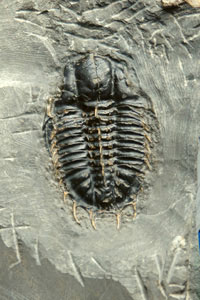Trilobites rich in evolutionary data
By Steve Koppess-koppes@uchicago.edu
News Office
 Photo by Dan Dry Mark Webster | |
Paleontologist Mark Webster has hunted a group of odd-looking fossilized creatures called trilobites from the northwest highlands of Scotland to the deserts of the American Southwest.
“They’re segmented little creatures, very beautiful to look at,” said Webster, Assistant Professor in Geophysical Sciences and the College. “They catch the eye of a lot of amateur collectors, and professionals tend to get hooked on them very easily.”
These ancient relatives of spiders and horseshoe crabs emerged from an unprecedented explosion of life on Earth more than 500 million years ago. They may help Webster pry loose some of the mysteries of evolution.
Extinct for 250 million years, trilobites once were the most common skeletonized animals in the world’s oceans. They ranged in size from nearly microscopic to more than a foot long, though most of the 17,000 known species measured from 1 to 4 inches. “They were very diverse. That, in combination with an abundance as fossils, means they’re great for studying evolutionary patterns in very old rocks,” Webster said.
Trilobites first appeared during what paleontologists call “the Cambrian explosion” or “the Cambrian radiation.” Before this time, life on Earth was limited mostly to bacteria, algae, single-celled organisms and only the simplest animal groups. But during the Cambrian Period, more complex creatures with skeletons, eyes and limbs evolved with amazing suddenness.
Webster specializes in the olenellids, the oldest and most primitive trilobite group to evolve. The olenellids also show a great deal of variation within species. “That led me into thinking there’s something weird about these very primitive Cambrian trilobites that you don’t see in other ones,” he said.
The olenellids of the early Cambrian seemed to display more variability than trilobites Webster had seen from later periods. The hunch led him to examine the characteristics of 982 species of trilobites, based on previously published reports. “It’s too much for one person to look at a thousand trilobite species,” Webster said.
 Photo by Dan Dry | |
For his study, Webster combed through 68 trilobite studies, searching for descriptions of evolving characteristics that could be incorporated into his analysis. After eliminating studies that were inappropriate for inclusion, 49 still remained, encompassing 982 species.
He focused on actively evolving characteristics. The trilobite head alone, for example, displays many such characteristics. These include differences in ornamentation, the number and placement of spines, and the shape of head segments.
Webster’s findings: Overall, approximately 35 percent of the 982 trilobite species exhibited some variation in some aspect of their appearance that was evolving. But more than 70 percent of early and middle Cambrian species exhibited variation, while only 13 percent of later trilobite species did so.
“There’s hardly any variation in the post-Cambrian,” he said. “Even the presence or absence or the kind of ornamentation on the head shield varies within these Cambrian trilobites and doesn’t vary in the post-Cambrian trilobites.”
This abundant variation within trilobite species likely helped fuel their proliferation and evolution, Webster reported in the July 27, 2007 issue of the journal Science. “From an evolutionary perspective, the more variable a species is, the more raw material natural selection has to operate on,” Webster said.
Paleontologists for decades have suspected that highly variable species evolved more rapidly than others, said Nigel Hughes, professor of earth sciences at the University of California, Riverside. “Various studies have approached questions pertaining to it—but this is the first to convincingly document it in any group,” Hughes said.
The paper is relevant to the big question of what fueled the Cambrian radiation and why that event was so singular. It appears that organisms displayed “rampant” within-species variation “in the ‘warm afterglow’ of the Cambrian explosion,” Hughes said, but not later. “No one has shown this convincingly before, and that’s why this is so important.”
Paleontologists have proposed two ideas to account for the declining variation within species through time. One is ecological: In the early Cambrian seas, fewer organisms existed than today, meaning they faced less competition for food. “You didn’t really have to be tightly specialized to make a living in the Cambrian,” Webster said.
But as evolution gave rise to more varieties of organisms, ecological communities became more diverse. “You had to be very fine-tuned to your particular niche to make a living and to beat out competitors for a limited resource.”
The genomic hypothesis offers a second explanation for the decline of within-species variation over time. According to this idea, internal processes in the organism were key factors. Various developmental processes interact with one another to control the growth and formation of body parts as organisms progress from egg to adult.
“It’s been suggested that early on in evolutionary history, in the Cambrian Period, the degree to which these different developmental processes interacted with each other within the organism was a lot less,” Webster said. “As a result, the constraints on what the final organism looked like were relatively low.”
Both hypotheses are equally viable, in light of Webster’s latest findings. “We need to tease apart what’s controlling this pattern of high within-species variation. There’s a lot more work to do,” he said.
![[Chronicle]](/images/sidebar_header_oct06.gif)